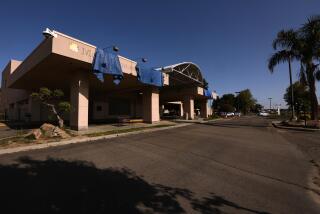VAN NUYS : The Comforts of Home During Hospital Stay
- Share via
Like many people, Donald Ferzoco had put off going to the hospital for surgery. Although he had been in pain since falling down a flight of stairs last October, he had heard too many horror stories about inattentive nurses, bland food and restrictive visitation hours.
But Valley Presbyterian Hospital in Van Nuys found the best medicine for Ferzoco’s sour attitude toward hospital care--lobster, a VCR and an overnight bed for his wife--at a 40% discount over normal hospital rates.
“They really cater to the patients,” said Ferzoco, 29, recovering from ligament surgery in his left leg in the hospital’s new Recovery Care Center, one of six state-sponsored pilot projects. “You can have lobster, steak or chicken. My wife was able to spend the night. Besides, this place doesn’t look like a hospital room, it looks like the Hilton.”
At a cost of about $150,000, the hospital outfitted 10 private rooms with oak furnishings, floral drapes, a color television, VCR and a chair that pulls out into a bed for visitors, said Terry Leggett, vice president for finance at Valley Presbyterian.
Opened in April, the care center has served more than 300 patients--all of whom required less than 48 hours of recovery care from surgery.
The center is one of six currently operating statewide as part of a pilot project by California’s Office of Statewide Health Planning and Development, said Gloria Robertson, director of the state pilot project. Two other area hospitals, Henry Mayo Newhall Memorial Hospital and the Santa Monica Hospital Medical Center, also have recovery centers.
The project will end next year, at which time Robertson’s office will report to the state Legislature on the merits of the recovery centers. So far, Robertson said the projects have been successful with their “homelike” quality of care and by charging less than a normal inpatient hospital stay.
At the Valley Presbyterian Recovery Care Center, costs to patients are cut by providing postoperative care only and charging in time increments of four hours, rather than a regular hospital daily rate, Leggett said.
Roger Richter, senior vice president of the California Assn. of Hospitals and Health Systems, which represents about 500 facilities statewide, said his organization has not gone so far as endorsing the care centers, but does see advantages to the “less regulatory environment” used by hospital-based recovery care centers.
In another unique characteristic of the center, friends, family and other significant others are allowed to visit 24 hours a day. In addition to providing voluntary care in the patients’ room that cuts down on nursing expenses, these visitors also are trained by nurses in medication, rehabilitation and skills that speed recovery at home.
This philosophy of “homelike” recovery fit perfectly with Ferzoco and his wife, Deborah, of Canoga Park.
“If I’m here, it makes him feel more comfortable,” said Deborah Ferzoco, 22, an elementary school teacher. “I’ve changed his sheets, pillowcases, given him a sponge bath. It’s been like a home with assistants outside the front door.”
More to Read
Sign up for Essential California
The most important California stories and recommendations in your inbox every morning.
You may occasionally receive promotional content from the Los Angeles Times.










